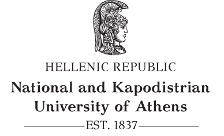- Αρχική
- THE PROGRAM
-
MODULES
- THE ARCHAEOLOGY OF BRONZE AGE AEGEAN (1010)
- KEY THEMES IN EASTERN MEDITERRANEAN ARCHAEOLOGY (1020)
- STATE FORMATION AND THE RISE OF POWER IN AN INSULAR WORLD: THE ARCHAEOLOGY OF MINOAN CRETE (3020)
- THE ARCHAEOLOGY OF MYCENAEAN GREECE (1050)
- COLLAPSE AND TRANSFORMATION: CRISIS, RESILIENCE, AND REORGANIZATION FROM THE LATE THIRD TO EARLY FIRST MILLENNIUM BCE IN THE EASTERN MEDITERRANEAN (3030)
- UNDERSTANDING THE ARCHAEOLOGICAL RECORD: PREHISTORIC CYPRUS AND THE EAST MEDITERRANEAN (2080)
- THE VISUAL CULTURES OF CLASSICAL GREECE (1030)
- ANCIENT GREEK SCULPTURE (1080)
- ATTIC POTTERY OF THE ARCHAIC AND CLASSICAL PERIODS (1090)
- THE ARCHITECTURE OF THE MYSTERY CULTS (2090)
- THE ARCHAEOLOGY OF DEATH IN THE ANCIENT GREEK WORLD (3010)
- STAFF
- ACTIVITIES
- ADMISSION
- RESOURCES
- CONTACT US
- NEWS AND EVENTS
THE ARCHAEOLOGY OF MYCENAEAN GREECE (1050)
Spring Semester, Optional module, 10 ECTS
Instructor: Vassilis Petrakis
Summary
The course focuses on the material culture of the Bronze Age Greek Mainland, with special emphasis placed on the Late Bronze Age (termed the Late Helladic or Mycenaean period, c. 1600-1050 BCE). Following a brief survey of the Early and Middle Bronze Age on the Greek Mainland (c. 3000-1600 BCE), in our meetings we will comprehensively overview key aspects of the Mycenaean material culture: domestic and funerary architecture, topography of key sites, including Mycenae, Tiryns, Pylos and Thebes, mortuary practices, arts and crafts, palatial administration, religion, and evidence for contact with regions beyond the Aegean with special emphasis on the relations with Egypt and Anatolia. Focus will be placed on the significance of textual evidence (in the form of palatial clay records bearing inscriptions in an early form of Greek rendered in the syllabic Linear B script) and its potential integration with the material archaeological record. The material of the aforementioned presentation is used as a basis for reconstructing Mycenaean social organization, economy and politics, focusing on the aspirations and structure of palatial administrations, the possible reasons behind the rise and collapse of the Mycenaean palatial polities and an assessment of the relationship between the Late Bronze Age Aegean world and the world of the heroes as represented in the Homeric epic.
Learning outcomes
Through attendance of these presentations and participation in discussions, participants should be acquainted with the main features of Mycenaean material culture (including some key sites) and the main debates about how we understand the Mycenaean world, its historical development and its structure.
Through working alone or in groups, students will be practiced in the study and interpretation of a rich and diverse archaeological record and in assessments over such key topics as secondary state formation and the emergence of the first literate administrations on the Greek Mainland. Critical analysis and assessments of previous scholarship will be strongly encouraged throughout the course.
Syllabus
The Course consists of the following sections:
- Introduction
- The Helladic background
- The Early Mycenaean world
- Death and Burial
- Knossos and the formation of the palatial world
- Settlement and architecture
- A survey of key sites of the palatial period
- Craft production
- Linear B and Aegean scripts
- The operation of the palace system
- Mycenaean religion
- Palatial collapse and Postpalatial developments
Assessment
*Essay: 70%
Oral presentation: 20%
Written work/ participation in discussions: 10%
*Participants are expected to produce one written essay (3.500-5.000 words) to be preceded by a mandatory oral presentation during our penultimate or final meeting. Advice on the extent, scope and structure of the essay will be provided throughout the course. A list of indicative topics will be formulated, but students are strongly encouraged to discuss, modify or even propose any essay topic in collaboration with the course instructor.
The quality of participation in discussions during the meetings will also be evaluated. Special presentations or discussions on select publications may also be assigned subject to an arrangement with the course instructor.
Student’s study hours
Lectures:26
Educational visits: 10
Study and analysis of bibliography: 40
Cooperation with the instructor: 30
Tutorials: 14
Independent study (incl. project): 30
Essay writing: 100
Course total: 250
Recommended Bibliography
Chadwick, J. 1976. The Mycenaean World, Cambridge.
Cline, E.H. (ed.) 2010. The Oxford Handbook of the Bronze Age Aegean (ca. 3000-1000 BC). Oxford. [Chapters 7, 10, 15-18, 20-21, 25, 27, 31-33, 35-36. Chapters 50-52 and 54 include good introductions to the sites of Mycenae, Pylos, Thebes and Tiryns respectively]
Dickinson, O.T.P.K. 2006. The Aegean from Bronze Age to Iron Age: Continuity and Change Between the Twelfth and Eighth Centuries BC, London [Chapters 2-3]
Galaty, M.L. & W.A. Parkinson (eds.) 2007. Rethinking Mycenaean Palaces II. Revised and Expanded Second Edition. The Cotsen Institute of Archaeology Monograph 60. Los Angeles.
Rutter, J.B. 1993. “The Prepalatial Bronze Age of the southern and central Greek Mainland”, AJA 97:4, 745-797.
Shelmerdine, C.W. (ed.) 2008. The Cambridge Companion to the Aegean Bronze Age. Cambridge [Chapters 2, 10-15]
Shelmerdine, C.W. 1997. “Review of Aegean Prehistory VI: The Palatial Bronze Age of the southern and central Greek Mainland” AJA 101:3, 537-585.
Voutsaki, S. & J.Τ. Killen (eds.) 2001. Economy and Politics in the Mycenaean Palace States. Proceedings of a Conference Held on 1-3 July 1999 in the Faculty of Classics. Proceedings of the Cambridge Philological Society Supplement 33. Cambridge.
